Edible bird's nest
Edible bird's nests are bird nests created by edible-nest swiftlets, Indian swiftlets, and other swiftlets using solidified saliva, which are harvested for human consumption. They are particularly prized in Chinese culture due to their rarity, high nutritional value in nutrients such as protein, and rich flavor. Edible bird's nests are among the most expensive animal products consumed by humans,[1] with nests being sold at prices up to about $3,000 per pound ($6,600/kg), depending on grading.[2] The type or grading of a bird's nest depends on the type of bird as well as the shape and color of the bird's nest. It is usually white in color, but there also exists a red version that is sometimes called "blood" nest. The Chinese believe that it promotes good health, especially for the skin.[3] The nests have been used in Chinese cooking for over 400 years, most often as bird's nest soup.[4]
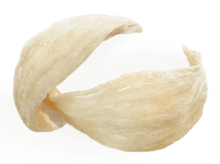 Edible bird's nest | |
| Region or state | Southeast Asia and East Asia |
|---|---|
| Associated national cuisine | Singapore, Malaysia, Indonesia, China, Taiwan, Thailand, Cambodia, Vietnam, Myanmar |
| Edible bird's nest | |||||||||||||||||||||||||||
|---|---|---|---|---|---|---|---|---|---|---|---|---|---|---|---|---|---|---|---|---|---|---|---|---|---|---|---|
| Traditional Chinese | 燕窩 | ||||||||||||||||||||||||||
| Simplified Chinese | 燕窝 | ||||||||||||||||||||||||||
| Literal meaning | "swallow nest" | ||||||||||||||||||||||||||
| |||||||||||||||||||||||||||
Etymology
The Chinese name for edible bird's nest, Chinese: 燕窩 (yànwō), translates literally as "swallow's (or swift's) nest"; in Indonesia "sarang burung walet" often serves as a synonym for bird's nest soup.
Culinary use
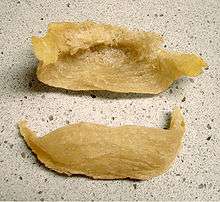
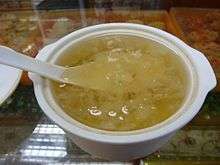
The best-known use of edible birds nest is bird's nest soup, a delicacy in Chinese cuisine.[1] When dissolved in water, the birds' nests have a favored gelatinous texture utilized in soup or sweet soup (tong sui). It is mostly referred to as 燕窩 (yànwō) unless references are made to the savory or sweet soup in Chinese cuisine.[5] According to the Ch'ing dynasty manual of gastronomy, the Suiyuan shidan, bird's nest was regarded as a delicate ingredient not to be flavored or cooked with anything overpowering or oily. While it is rare and expensive, it must be served in relatively large quantities; otherwise its texture cannot be fully experienced and enjoyed.[6]
In addition to their use in soup, edible bird's nests can be used as an ingredient in other dishes. They can be cooked with rice to produce bird's nest congee or bird's nest boiled rice, or they can be added to egg tarts and other desserts. A bird's nest jelly can be made by placing the bird's nest in a ceramic container with minimal water and sugar (or salt) before double steaming.
Production and harvest
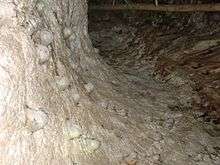
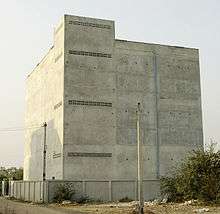
The most heavily harvested nests are from the edible-nest swiftlet or white-nest swiftlet (Aerodramus fuciphagus) and the black-nest swiftlet (Aerodramus maximus).[7] The nests are rich in nutrients such as protein, and are traditionally believed to provide health benefits.[4] The composition of EBN makes it esteemed as a nutritional food. Protein and carbohydrate are known to be major composition fraction of EBN which comprising 50-60% and 30-40% respectively.[8][9][10][11] Previous studies conducted by Lee et al., have reported that the nutrient composition of EBN is dependent on the country of origin,[8] food intake of the birds, climate and breeding sites. Most nests are built during the breeding season by the male swiftlet over a period of 35 days. They take the shape of a shallow cup stuck to the cave wall. The nests are composed of interwoven strands of salivary cement. Both nests have high levels of calcium, iron, potassium, and magnesium.[1]
The nests were formerly harvested from caves, principally the enormous limestone caves at Gomantong and Niah in Borneo. With the escalation in demand these sources have been supplanted since the late-1990s by purpose-built nesting houses, usually reinforced concrete structures following the design of the Southeast Asian shop-house ("rumah toko"/"ruko").[12] These nesting houses are normally found in urban areas near the sea, since the birds have a propensity to flock in such places. It has become an expanding industry as is evident in such places as the province of North Sumatra or the Pak Phanang District in Thailand. From those places the nests are mostly exported to the markets in Hong Kong, which has become the center of the world trade in bird's nests; the industry is valued at around HK$2 billion per year,[13] although most of the final consumers are from mainland China. China is the world's largest consumer of birds' nests, accounting for more than 90 percent of consumption.[13]
In some places, nest gatherers have seen a steep decline in the number of birds and a rise in unexplained fatalities.[14]
Colour of bird's nest
Bird's nest is usually white in colour, but there also exists a red version, called “blood nest” (血燕, xuĕ yàn), which is significantly more expensive and believed to have more medicinal value. In the market, a kilogram of white bird's nest can fetch up to US$2,000, and a kilogram of red nests up to US$10,000.
The reason for the red colour has been a puzzle for centuries. Contrary to popular beliefs, red bird’s nest does not contain haemoglobin, the protein responsible for the red colour in blood.[1] Researcher has reported in 2013 that 'bird soil' containing guano droppings from bird houses were able to turn white edible bird's nests red and the red colour of edible bird's nests is likely caused by the environmental factors in cave interiors and bird houses.[15]
Subsequently, a research team at Nanyang Technological University, Singapore has found that the red colour is caused by the vapour of reactive nitrogen species, in the atmosphere of the bird house or cave, reacting with the mucin glycoprotein of the initially formed white bird nest. Red bird’s nest contains tyrosine that has combined with reactive nitrogen species to form a new molecule called 3-nitrotyrosine. At high concentrations, this molecule produces a rich red colour, while at lower concentrations, it produces the yellow, golden and orange colours seen in other varieties of bird’s nest products.[16][17]
The researchers also note that the bird nest also readily absorbs nitrite and nitrate from the vapour in this process which explains why the red bird’s nest contains a high concentration of nitrite and nitrate which are known to lead to carcinogenic compounds. This may mean that non-white bird’s nest is harmful to human health.[16][18]
Medicinal Properties
People believe and claim that EBN has medicinal values which is beneficial for human health. There are some published literatures and scientific proves on these medicinal claims which could justify the therapeutic effects of EBN extract. Previously, the effect of EBN on the proliferation of corneal keratocytes has been investigated using white rabbits in vitro. [19] It was shown that EBN was safe to cornea and it has the ability to produce cell proliferative activity of corneal keratoytes. This study reveals the potential use of EBN to treat corneal wound healing.
In one study, EBN extract has been claimed to have potential as an osteoarthritis treatment.[20] Osteoarthritis is a degenerative joint disease that results in the destruction of cartilage. In this study, they claimed EBN extract contains important components that can reduce the progression of osteoarthritis by reducing the catabolic activities of human articular chondrocytes resulting in the regeneration of the cartilage.
Besides with its physicochemical properties, the antioxidant and antibacterial activity of EBN also have been investigated previously .[11][21] Antioxidant is a vital factor to fight against oxidative stress and reduce the cause of chronic oxidative stress-related diseases. Based on the analysis done, EBN extracts demonstrated antioxidant effects and this activity was probably due to the amino acids present in the EBN detected in the EBN. For instance, Cys, Met, His, Try and Lys are the amino acids that have been proven for their antioxidant activities.[11] In the other study conducted by Quek et al., it was revealed that antioxidant activity of EBN was significantly varied and influenced by its production, species and geographical origins. They also suggested that EBN could be a potential source for a natural source of antioxidant which is beneficial for the food industry as an alternative to replace the use of synthetic antioxidants.[21]
Market
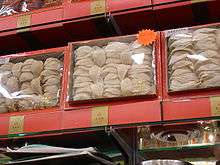
Indonesia is the largest bird's nest producer in Southeast Asia, exporting around 2,000 tonnes per year, followed by Malaysia at 600 tonnes, and Thailand, 400 tonnes. The Philippines, around five tonnes per year, is the smallest producer.[13]
The bird's nest industry in 2014 accounts for 0.5 percent of the Indonesian GDP, a GDP percentage equivalent to about a quarter of the country's fishing industry. In Thailand, the trade value of bird's nests, both wild and "farmed", is estimated at around 10 billion baht per year.[13] The industry globally is an estimated US$5 billion.[22]
Hong Kong and the United States are the largest importers of nests.[23] In Hong Kong, a bowl of bird's nest soup costs US$30 to US$100.[4][23]
Counterfeiting
Besides the natural coloration process, the white nests can be treated with red pigment to defraud buyers, but methods have been developed to determine an adulterated nest. Natural red cave nests are often found in limestone caves in Pak Phayun District, Thailand.[1][13] The high returns and growing demand have attracted counterfeiters, leading to the halt of Malaysian nest exports to China. The Malaysian government has since employed RFID technology to thwart counterfeiting by micro-chipping nests with details about harvesting, packaging, and transport.[24] Industrial quality-control techniques such as failure mode and effects analysis have been applied to bird's nest processing at nesting houses in Sarawak, Malaysia and reported by a research team at Universiti Malaysia Sarawak.[25][26][27]
Authentication
The high demand for EBN has garnered the attention of counterfeiters to defraud buyers. Fake EBN or EBN with adulterants may be harmful to those who consume it. Hence, there is an urgent need to find a solution to the issues regarding the authenticity and quality of the EBN. Numerous sophisticated techniques have been used for the detection of adulterants in EBN such as energy disperse X-ray microanalysis, electronic microscopy and spectroscopy.[28] Some other methods including DNA- based polymerase chain reactions, protein-based two-dimension gel electrophoresis and genetic identification based on mitochondrial DNA have found applications in the authentication of EBN. Previously study used gel electrophoresis in combination with liquid chromatographic methods to identify some common adulterants in EBN.[8][29] In this study, gel electrophoresis and liquid chromatographic were used for protein profiling and amino acids studies of cave and house nests, and others samples such as white fungus, fish swimming bladder, jelly and egg white. Each of the samples had a unique protein profile which will be reflected on the protein gel and these results were supported by the chromatographic analysis. Besides, gel electrophoresis also was used to identify and differentiate the EBN base on their geographical origins.[8] This is due to the several advantages that make gel electrophoresis remains to be a popular option for analytical study; it is simple in operation, cost-effective and offers high sensitivity to the sample compared to other electrophoresis methods.
Import restrictions
Because a bird's nest is an animal product, it is subject to strict import restrictions in some countries, particularly with regard to H5N1 avian flu.
In Canada, commercially prepared, canned, and sterile bird's nest preparations are generally acceptable, but may be subject to import restrictions.[30]
References
- Marcone, Massimo F. (1 July 2005). "Characterization of the edible bird's nest the 'Caviar of the East'". Food Research International. 38 (10): 1125–1134. doi:10.1016/j.foodres.2005.02.008. ISSN 0963-9969.
- "eBay search: edible bird's nest, sold". Retrieved 7 March 2017.
- Maierbrugger, Arno (20 August 2013). "Vietnam seeks investors for edible bird's nest industry". Inside Investor. Retrieved 20 August 2013.
- Hobbs, Joseph J. (2004). "Problems in the harvest of edible birds' nests in Sarawak and Sabah, Malaysian Borneo". Biodiversity and Conservation. 13 (12): 2209–2226. doi:10.1023/b:bioc.0000047905.79709.7f.
A few species of swift, the cave swifts, are renowned for building the saliva nests used to produce the unique texture of this soup
- "knowledge about Bird's nest 燕窩小知識". Retrieved 22 April 2020.
- "Seafoods 1: Bird's Nest (燕窩)". Translating the Suiyuan Shidan. 2014.
- Gausset, Quentin (2004). "Chronicle of a Foreseeable Tragedy: Birds' Nests Management in the Niah Caves (Sarawak)". Human Ecology. 32 (4): 487–506. doi:10.1023/b:huec.0000043517.23277.54.
- Hun, Lee Ting; Wani, Waseem A.; Poh, Heng Yong; Baig, Umair; Ti Tjih, Eddie Tan; Nashiruddin, Noor Idayu; Ling, Yong Ee; Aziz, Ramlan Abdul (2016). "Gel electrophoretic and liquid chromatographic methods for the identification and authentication of cave and house edible bird's nests from common adulterants". Analytical Methods. 8 (3): 526–536. doi:10.1039/c5ay02170g. ISSN 1759-9660.
- Tan, Sin Nee; Sani, Dahiru; Lim, Chee Woei; Ideris, Aini; Stanslas, Johnson; Lim, Christopher Thiam Seong (21 January 2020). "Proximate Analysis and Safety Profile of Farmed Edible Bird's Nest in Malaysia and Its Effect on Cancer Cells". Evidence-Based Complementary and Alternative Medicine. 2020: 1–12. doi:10.1155/2020/8068797. ISSN 1741-427X.
- Chua, Yong Guan; Bloodworth, Bosco Chen; Leong, Lai Peng; Li, Sam Fong Yau (5 May 2014). "Metabolite profiling of edible bird's nest using gas chromatography/mass spectrometry and liquid chromatography/mass spectrometry". Rapid Communications in Mass Spectrometry. 28 (12): 1387–1400. doi:10.1002/rcm.6914. ISSN 0951-4198.
- Lee et al., 2018. "Investigations into the physicochemical, biochemical and antibacterial properties of Edible Bird's Nest" (PDF). Journal of Chemical and Pharmaceutical Research. 7: 228–247.
- "Inside of a Successful Bird's Nest House". House of Bird's Nest. Archived from the original on 9 January 2014. Retrieved 9 January 2014.
- Panyaarvudh, Jintana (11 October 2018). "An economic nesting ground". The Nation. Retrieved 12 October 2018.
- https://www.bbc.com/reel/video/p07fnkb5/the-remote-island-of-nest-gatherers
- But, Paul Pui-Hay; Jiang, Ren-Wang; Shaw, Pang-Chui (9 January 2013). "Edible bird's nests--how do the red ones get red?". Journal of Ethnopharmacology. 145 (1): 378–380. doi:10.1016/j.jep.2012.10.050. ISSN 1872-7573. PMID 23142487.
- Shim, Eric Kian-Shiun; Lee, Soo-Ying (6 June 2018). "Nitration of Tyrosine in the Mucin Glycoprotein of Edible Bird's Nest Changes Its Color from White to Red". Journal of Agricultural and Food Chemistry. 66 (22): 5654–5662. doi:10.1021/acs.jafc.8b01619. ISSN 0021-8561.
- "How Edible Bird's Nest Changes Colour From White to Red". Avian Science Institute. 20 December 2018. Retrieved 14 June 2020.
- "Highlight: Colour of Bird's Nest". spms.ntu.edu.sg. Retrieved 14 June 2020.
- Zainal Abidin, Fadhilah; Hui, Chua Kien; Luan, Ng Sook; Mohd Ramli, Elvy Suhana; Hun, Lee Ting; Abd Ghafar, Norzana (12 October 2011). "Effects of edible bird's nest (EBN) on cultured rabbit corneal keratocytes". BMC Complementary and Alternative Medicine. 11 (1). doi:10.1186/1472-6882-11-94. ISSN 1472-6882.
- Chua, Kien-Hui; Lee, Ting-Hun; Nagandran, Kamini; Md Yahaya, Nor Hamdan; Lee, Chew-Tin; Tjih, Eddie Tan Ti; Abdul Aziz, Ramlan (22 January 2013). "Edible Bird's nest extract as a chondro-protective agent for human chondrocytes isolated from osteoarthritic knee: in vitro study". BMC Complementary and Alternative Medicine. 13 (1). doi:10.1186/1472-6882-13-19. ISSN 1472-6882.
- Quek, Meei Chien; Chin, Nyuk Ling; Yusof, Yus Aniza; Law, Chung Lim; Tan, Sheau Wei (July 2018). "Characterization of edible bird's nest of different production, species and geographical origins using nutritional composition, physicochemical properties and antioxidant activities". Food Research International. 109: 35–43. doi:10.1016/j.foodres.2018.03.078. ISSN 0963-9969.
- "Vietnam Seeks Millions for Edible Bird Spit Industry". Bloomberg News. Retrieved 9 January 2014.
- Park, Therese (8 February 2005). "Bird-nest Soup, Anyone?". Koreabridge Writings.
- "Chinese Delicacy Tagged with RFID". RFID World. 30 June 2012. Retrieved 20 January 2013.
- Jong, Chian Haur; Tay, Kai Meng; Lim, Chee Peng (August 2013). "Application of the fuzzy Failure Mode and Effect Analysis methodology to edible bird nest processing" (PDF). Computers and Electronics in Agriculture. 96: 90–108. doi:10.1016/j.compag.2013.04.015.
- Tay, Kai Meng; Jong, Chian Haur; Lim, Chee Peng (July 2014). "A clustering-based failure mode and effect analysis model and its application to the edible bird nest industry" (PDF). Neural Computing and Applications. 26 (3): 551–560. doi:10.1007/s00521-014-1647-4.
- Chang, Wui Lee; Tay, Kai Meng; Lim, Chee Peng (November 2015). "Clustering and visualization of failure modes using an evolving tree" (PDF). Expert Systems with Applications. 42 (20): 7235–7244. doi:10.1016/j.eswa.2015.04.036.
- Wong, Hing-Lok; Siu, Wing-sum; Shum, Wai-ting; Gao, Si; Leung, Ping-Chung; Ko, Chun-Hay (December 2012). "Application of chinese herbal medicines to revitalize adult stem cells for tissue regeneration". Chinese Journal of Integrative Medicine. 18 (12): 903–908. doi:10.1007/s11655-012-1293-3. ISSN 1672-0415.
- Lee, Ting Hun; Wani, Waseem A.; Koay, Yin Shin; Kavita, Supparmaniam; Tan, Eddie Ti Tjih; Shreaz, Sheikh (October 2017). "Recent advances in the identification and authentication methods of edible bird's nest". Food Research International. 100: 14–27. doi:10.1016/j.foodres.2017.07.036. ISSN 0963-9969.
- "Egg Products - Import Procedures". Canadian Food Inspection Agency. 2014. Retrieved 29 July 2014.
Bibliography
- Jordan, David (2004). "Globalisation and Bird's Nest Soup". International Development Planning Review. 26 (1): 97–110. doi:10.3828/idpr.26.1.6. Archived from the original on 21 October 2008.
- Lau, Amy S. M.; Melville, David S. (April 1994). International Trade in Swiftlet Nests with Special Reference to Hong Kong. Traffic Network. ISBN 978-1-85850-030-0.
- Jong, Chian Haur; Tay, Kai Meng; Lim, Chee Peng (August 2013). "Application of the fuzzy Failure Mode and Effect Analysis methodology to edible bird nest processing" (PDF). Computers and Electronics in Agriculture. 96: 90–108. doi:10.1016/j.compag.2013.04.015.
- Tay, Kai Meng; Jong, Chian Haur; Lim, Chee Peng (April 2015). "A clustering-based failure mode and effect analysis model and its application to the edible bird nest industry" (PDF). Neural Computing and Applications. 26 (3): 551–560. doi:10.1007/s00521-014-1647-4.
- Ting Hun Lee; Syieluing Wong; Chia Hau Lee; Nurul Alia Azmi; Murugiah Darshini; Supparmaniam Kavita and Kian Kai Cheng (August 2019). "Identification of Malaysia’s Edible Bird’s Nest Geographical Origin Using Gel Electrophoresis Analysis". Chiang Mai University Journal of Natural Science. 19 (3): 379-392. doi.org/10.12982/CMUJNS.2020.0025
- Chang, Wui Lee; Tay, Kai Meng; Lim, Chee Peng (November 2015). "Clustering and visualization of failure modes using an evolving tree" (PDF). Expert Systems with Applications. 42 (20): 7235–7244. doi:10.1016/j.eswa.2015.04.036.
- Chai, Kok Chin; Jong, Chian Haur; Tay, Kai Meng; Lim, Chee Peng (August 2016). "A Perceptual Computing-based Method to Prioritize Failure Modes in Failure Mode and Effect Analysis and Its Application to Edible Bird Nest Farming" (PDF). Applied Soft Computing. 49: 734–747. doi:10.1016/j.asoc.2016.08.043.
- Hun Lee Ting; Waseem A. Wani; Heng Yong Poh; Umair Baig; Eddie Tan Ti Tjih; Noor Idayu Nashiruddin; Yong Ee Ling; Ramlan Abdul Aziz (November 2015). "Gel electrophoretic and liquid chromatographic methods for the identification and authentication of cave and house edible bird's nests from common adulterants". Analytical methods 8 (3): 526-536. doi.org/10.1039/C5AY02170G.
- Ting Hun Lee; Waseem A. Wani; Yin Shin Koay; Supparmaniam Kavita; Eddie Ti Tjih Tan; Sheikh Shreaz (October 2017). "Recent advances in the identification and authentication methods of edible bird's nest." Food research international 100: 14-27. doi.org/10.1016/j.foodres.2017.07.036
Further reading
- Jandam, Kasem (April 2017). Ethnicity and birds' nest resources in Southeast Asia. Thailand Research Fund (TRF). ISBN 978-616-7474-53-3. Retrieved 12 October 2018.
- Ting Hun, Lee., Wassem, A. Wani., & Eddie, Tan Ti Tjih (2015). Edible bird's nest: An Incredible salivary bioproduct from swiflets. LAP LAMBERT Academic Publishing. ISBN 978-3659792557.
External links
